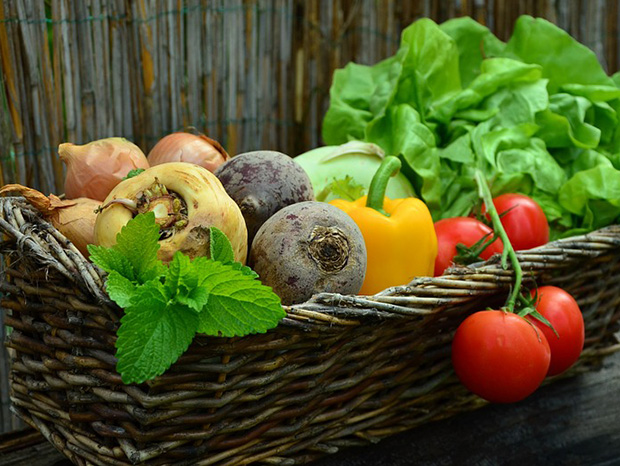Vegetables
Plants that will be ready for harvesting this month
beets, broccoli, cauliflower, cucumbers, kale, lettuce, peas, potatoes, radishes, summer squash, carrots, tomatoes, turnips, and peppers.
Harvest vegetables regularly as they ripen. This will encourage the plants to continue to produce. Peppers, cucumbers, squash, eggplants, tomatoes and green beans will especially appreciate this. Harvest okra before the pods are over 3” long. Overly mature pods have a woody texture.
Stop cutting rhubarb to allow the plant to store energy for next year’s harvest.
For potatoes in bags, continue to pile compost, keeping the sun off potato skins, until the bag is full.
Pinch off side shoots and suckers on tomato plants. You will get fewer tomatoes, but the quality will be better. Take off any leaves below the first stems with ripening fruit to aid air circulation. Support tomatoes with stakes or cages keeping fruit off the ground. Keeping leaves off the ground is important too as fungal spores exist in the soil.
Feed tomatoes, squash and cucumbers now. Espoma’s organic Garden-Tone makes this an easy task and is made specifically for vegetable gardening.
Garlic can be harvested as soon as the tops begin to yellow and droop.
Continue to remove any flowers from herb plants. Get some herbs started in containers to bring into the kitchen in the fall. You can freeze herb leaves, so pick extra to use in the fall and winter.
To promote more branching on squash and zucchini plants, snip off the growing tips.
For eggplants, snip off the growing tip when 5 fruits are showing.
When melon plants produce four fruits begin to remove new blossoms.
Watch for Tomato Blight. There are 3 different fungal diseases associated with blight, but the treatment is pretty easy. Learn more about Tomato Blight here.
Watch for Blossom End Rot. You’ll notice soft areas that darken on the blossom end (opposite the stem) of tomatoes, peppers, squash, and melons. Caused by a calcium deficiency, Blossom End Rot needs attention as soon as you see it begin. Click to learn what to do about Blossom End Rot.
Watch for Cabbage Loopers. Loopers can show up on cabbage, broccoli, brussels sprouts, cauliflower, kale, lettuce, spinach, beans, peas, celery, parsley, parsnips, radishes, potatoes, and tomatoes. Click here to learn what to do about Loopers.
Watch for insect pests such as aphids. If you’re vigilant and catch insects when they first show up, you may be able to save your plants from damage by hosing them off or picking insects off by hand.
Go ahead and plant cool-season vegetable transplants such as broccoli cabbage and cauliflower, so you’ll have a harvest in the fall. They’ll appreciate being shaded during the hottest part of the day until next month when they can get full sun.
Sow seeds for kale, beets, carrots, and radishes for fall harvest. Plant seeds slightly deeper than in spring to protect them from the hotter sun. Reminder: Most vegetables prefer a soil pH of 6 to 7.
Fruits & Berries
Prune cherry, peach, plum, and apricot trees this month. Creating good air circulation helps prevent disease.
Apple trees will begin to show suckers and water sprouts. These need to be pruned off.
Pinch off the tips of side shoots on fig trees after 5 leaves are present.
This month you can keep runners on strawberry plants, which can be staked down to create more plants for next year. Otherwise, runners can be cut off.
Netting can help keep birds from harvesting your blueberries for you!
Make sure raspberry bushes are getting enough water in the hot months as they are shallow rooted plants.

